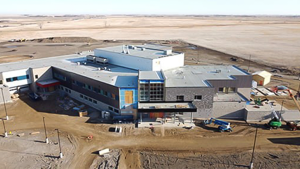While public-private partnerships (P3s) have been impacted by the COVID-19 pandemic in the same way as other infrastructure builds, a lot of projects have been able to continue, and some, such as hospitals and schools, have even been accelerated.
“The reality is on balance. The sector has performed well, our projects are continuing on,” said Mark Romoff, president and CEO of the Canadian Council for Public-Private Partnerships (CCPPP).
“There is no doubt that projects have been slowed a little bit because everybody is focused first and foremost on worker safety and health. What you are seeing happening is some projects have been delayed a little bit and of course that has cost implications for companies which is a concern for them.”
The CCPPP has been encouraging the government to provide relief to companies to get them through the tough time.
“We want these very same companies to be the ones that are there when the stimulus programs and the recovery plans are announced. For them to remain viable is really critically important,” said Romoff.
“Economic growth and prosperity and job creation are going be at the heart of every government’s initiative in the recovery and that’s not unique to Canada, that will be a global phenomenon.”
The federal government is looking to the Canada Infrastructure Bank as an organization that can play a key role in the recovery plans, Romoff added.
Education in some cases is being ramped up because…kids aren’t in school,
— David Thom
IBI Group
Technology is one of the tools that will help the country get through the crisis.
“We really need to get much more innovative in order to get projects delivered quickly because there will certainly be a focus at the stimulus phase to get projects moving,” he said. “The construction sector is one of those that, for the longest time, has been a bit of a laggard when it comes to adoption of new technologies. I think now the pressure will be on everyone to deliver quicker while making sure your outcomes are as good as strong in terms of getting things built quickly within budgets.”
David Thom, president of IBI Group, told the Daily Commercial News the pandemic has not changed the pace of some P3 projects.
“In the P3 world, which is primarily public infrastructure being delivered in partnership with the private sector, we are not seeing that slow down. In some cases it’s actually increasing,” he said. “Education in some cases is being ramped up because they are taking advantage of the fact that kids aren’t in school so they are looking to potentially accelerate certain programs.”
With P3s the big change is about building in pandemic resilience and that varies by different project types, added Thom. The pandemic is going to change the way transportation, transit, schools and hospitals projects are designed and operate.
“There is going to have to be some thought to what resiliency means in those facilities and what role each of the different players, the private and the public sector, are going to play in that,” said Thom. “The projects in the pipeline have the chance to adapt. The ones that are out there, there is going to have to be a rethinking of those ones as well because all of that infrastructure is going to need to have built in resilience which was never planned.
“People build in resilience for natural disasters, climate change, earthquakes but nobody has really built in a global pandemic,” Thom added. “It’s going to require a lot of flexibility and a P3 model is inherently not that flexible in terms of incorporating unforeseen things.”
There is going to be a lot of emphasis on technology and managing the economy in a much more integrated manner with smart city platforms, data control centres, integrated control centres. Those types of projects are ideally suited as P3 projects, he said.
Lou Serafini Jr., president and CEO of Fengate Asset Management, said it’s unclear how the new safety rules are going to affect project schedules.
“If you have less people working in proximity, how is this going to affect productivity?” asked Serafini. “If that’s the case, these projects will take longer and, in the P3 world, that will have an impact on substantial completion dates. Those delays tend to cost money, insurance and sometimes penalties.”
In the future, it will be necessary to rethink the design and delivery of projects, he said
“Do those designs support new measures for safety with respect to transmitting viruses?” asked Serafini. “For instance, how many private rooms they have at a hospital compared to shared rooms, a new standard of design for long-term care homes, especially where they tend to have many rooms that are shared. The other impact that has to be revisited is how is delivery of that work going to take place, safety measures on the site? How will you protect construction workers? How do you protect the workers in the building?”
Follow the author on Twitter @DCN_Angela.











Recent Comments
comments for this post are closed